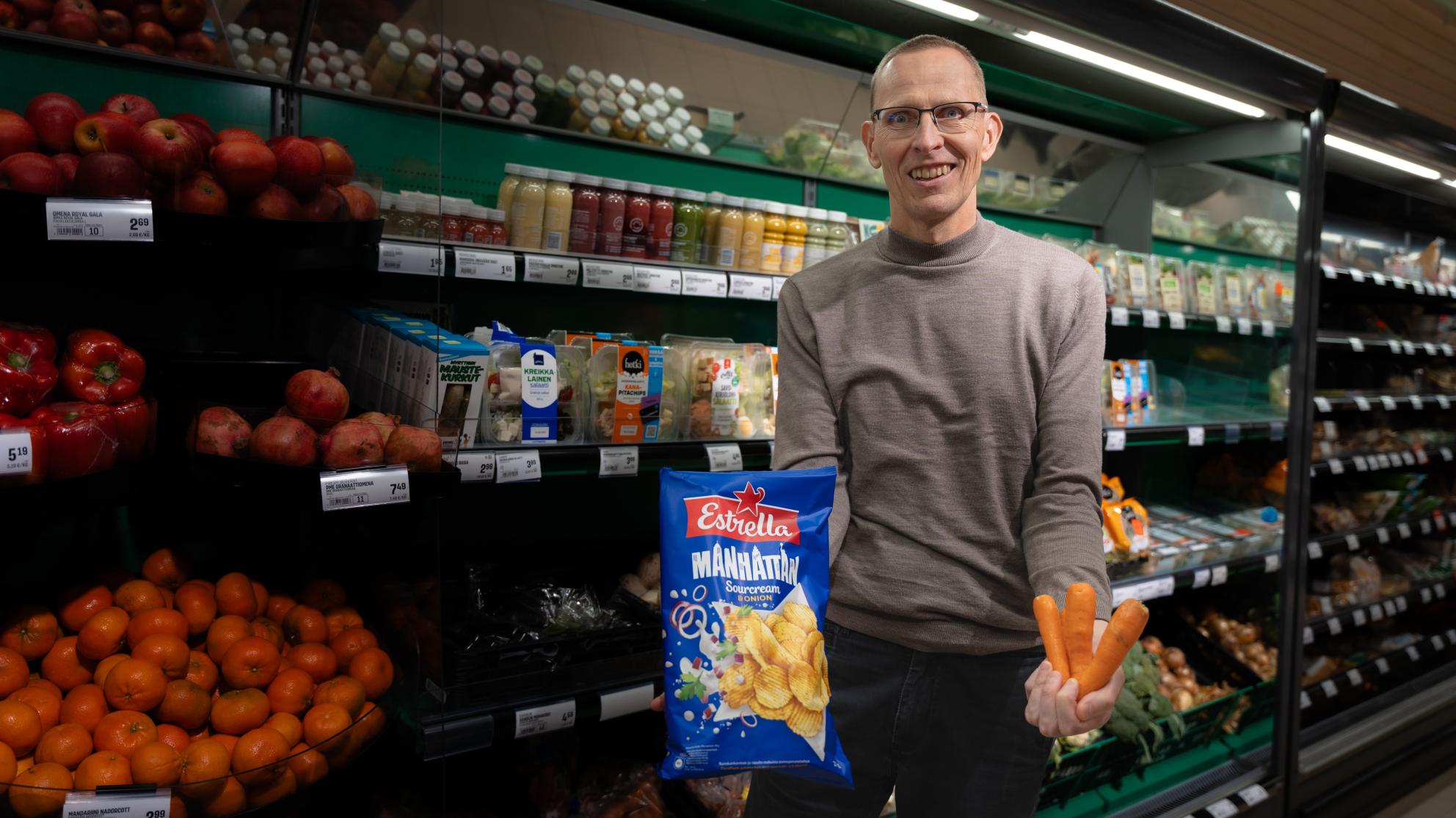Crisps or carrots? How consumers can be guided towards healthier food choices at the supermarket

The growing issue of obesity can be addressed by tempting food shoppers to make healthier choices at the supermarket. A new study from the University of Vaasa reveals that visual, smell, and taste cues can activate consumers' well-being goals, guiding them towards healthier food options and encouraging them to make less indulgent choices.
– Well-being can be seen as a state of flourishing that results from happiness and fulfilment which are facilitated by good health, says Professor Harri Luomala, an expert in consumer behaviour at the University of Vaasa.
Many consumers aim to make healthy food choices. They know, in theory, how to eat healthily, but putting this knowledge into practice can be challenging amid the demands of everyday life. The reasons for making unhealthy choices may lie in time constraints, seeking the easier option, lack of motivation, or the strong appeal of enjoyable food in marketing and media environments. When you are in the store, hungry, or in a bad mood with a child in tow, giving in to unhealthy temptations can be easy.
– As humans, we are inherently pleasure-seekers. Often, short-term pleasures are more attractive than the abstract long-term benefits of health and weight loss, explains Luomala.
Life without treats is almost a death sentence
Consumers can promote their well-being through various dietary choices: healthy products like fruits, enjoyable ones like ice cream, or responsible ones like organic vegetables. In the latter case, the satisfaction, often referred to as a "warm glow", comes from considering the environment.
Many of us are familiar with the feeling of intending to have just one piece of chocolate or a handful of crisps, only to find ourselves consuming more than planned. This often results in a nagging, guilty conscience that urges to exercise.
However, Luomala is more forgiving. To be happy, we need moments of pleasure. There is a clear distinction between indulging and over-indulging, with the former often seen as a reward.
– Studies have shown that consumers often find that indulgent moments improve their well-being. Someone who eats strictly healthy all the time does not ultimately feel well. Consumers believe that a life without treats is almost like a death sentence.
"As humans, we are inherently pleasure-seekers. Often, short-term pleasures are more attractive than the abstract long-term benefits of health and weight loss."

Guiding toward healthier choices with signals that appeal to the senses
Many purchase decisions are made in the store, often without much conscious thought. The store environment provides numerous cues and stimuli, but they affect individuals differently.
Luomala conducted two experiments in the same Finnish supermarket eight months apart to investigate how activating consumers' well-being goals impacted their shopping behaviour. In the first experiment, digital displays featured a picture of someone enjoying blueberry yoghurt in a forest with a text that said “Feel good” in Finnish along with recipes for a nutrient-rich berry smoothie and a warming lentil soup. In the second experiment, visual cues included floor stickers and shopping cart advertisements. The sense of smell was activated by spreading the scent of basil, while the sense of taste was triggered by offering carrot samples.
– These tangible sensory cues can subtly activate abstract goals, such as well-being, status and responsibility. They can guide consumers' choices in the store, says Luomala.
For example, images of elegant food packaging and table settings are associated with health in people's minds. Store temperature can also influence perceptions: the cooler it is, the more people tend to think it is a high-status place.
– Previously, research has shown that exposure to high-pitched music can activate moral beliefs in listeners. What could be more morally right in the consumer's mind than choosing a healthy option over an unhealthy one?
Colours can also activate abstract motivations. In Western culture, the colour gold signifies status. Waiters get larger tips in a restaurant with gold-coloured tablecloths.
Does buying organic mean that you are wealthy and smart?
Shopping for groceries involves value judgments, common beliefs, as well as social and economic considerations. According to Luomala, people often imagine that organic products are healthier than conventional ones, but there is no scientific evidence that one is more nutritionally beneficial than the other.
– Choosing organic can also send social signals. If you know someone who buys organic, you might assume that they earn well and are intelligent – they are not selfish but considerate of others.
However, in all products, organic does not necessarily mean better quality. While people believe that organic vegetables taste better than conventional ones, this may not hold for indulgent products. In the case of meat or chocolate, organic might signal that the product tastes worse or is drier than conventional options.
Of course, the meaning attached to products changes over time and, in the era of social media, quite rapidly. Red meat was long seen as a symbol of power and wealth, but Luomala notes that the symbolism is now shifting, especially among young consumers.
– Few people these days would dare to post a picture of an imported Argentinean steak on social media.
"Choosing organic can also send social signals. If you know someone who buys organic, you might assume that they earn well and are intelligent – they are not selfish but considerate of others."

Promoting well-being through eating – the responsibility of the individual or society?
Rising food prices are evident in many consumers' grocery bills and kitchens. When prices are high, healthy food may be left unpurchased or replaced with unhealthy alternatives. According to Luomala, there is a risk that when prices rise, unhealthy eating increases. For example, in the United States, low-income consumers find it challenging to make healthy dietary choices partly due to economic factors. Unhealthy food is not only cheaper but it is also often available on special offers.
– It should not be solely up to consumers. Authorities, food producers, and retailers should also consider ways to support healthy eating. Should we have a sugar tax or vegetable and fruit subsidies? We need traditional discussions about rewards and punishments, says Luomala.
Preparation is the key to making healthier choices in the store
The study's results show that when well-being goals are activated in the store, consumers tend to purchase healthier options. They find their way towards areas in the store where healthier options are available, such as the fruit and vegetable section. At the same time, sales of yoghurt, vegetables, and products labelled as heart-healthy increase.
– When well-being goals are activated, sweets initially appear attractive, but interestingly, indulging in them can be prevented. This is perhaps because the reward system in the brain is satisfied by merely imagining eating them. Consequently, sales of indulgent foods like ice cream and ground beef may decrease, says Luomala.
How can you make healthier choices in the grocery store? Harri Luomala offers some tips. 1. Do not go to the store hungry; have a tryptophan-rich snack, such as a milk-based shake or nuts, beforehand. 2. Write a shopping list and stick to it. 3. Avoid danger zones like the bakery section and the candy aisles. 4. Just before going to the store, imagine enjoying a treat vividly and in detail to satisfy multiple senses.

